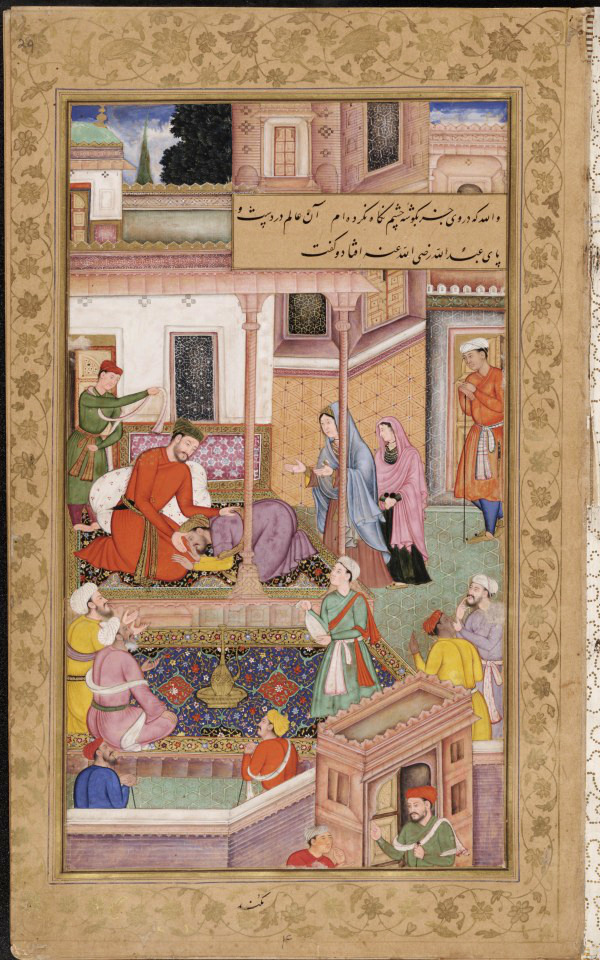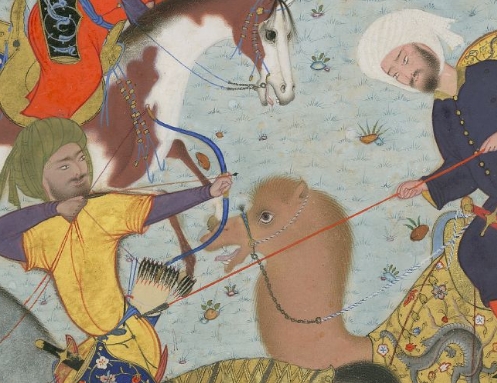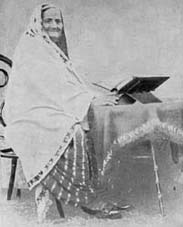|
Jami
Nūr ad-Dīn 'Abd ar-Rahmān Jāmī ( fa, نورالدین عبدالرحمن جامی; 7 November 1414 – 9 November 1492), also known as Mawlanā Nūr al-Dīn 'Abd al-Rahmān or Abd-Al-Rahmān Nur-Al-Din Muhammad Dashti, or simply as Jami or Djāmī and in Turkey as Molla Cami, was a Persian Sunni poet who is known for his achievements as a prolific scholar and writer of mystical Sufi literature. He was primarily a prominent poet-theologian of the school of Ibn Arabi and a Khwājagānī Sũfī, recognized for his eloquence and for his analysis of the metaphysics of mercy. His most famous poetic works are ''Haft Awrang, Tuhfat al-Ahrar, Layla wa Majnun, Fatihat al-Shabab, Lawa'ih, Al-Durrah al-Fakhirah.'' Jami belonged to the Naqshbandi Sufi order. Biography Jami was born in Kharjerd, in Khorasan. Previously his father Nizām al-Dīn Ahmad b. Shams al-Dīn Muhammad had come from Dasht, a small town in the district of Isfahan. A few years after his birth, his family mi ... [...More Info...] [...Related Items...] OR: [Wikipedia] [Google] [Baidu] |
Jami Rose Garden
Nūr ad-Dīn 'Abd ar-Rahmān Jāmī ( fa, نورالدین عبدالرحمن جامی; 7 November 1414 – 9 November 1492), also known as Mawlanā Nūr al-Dīn 'Abd al-Rahmān or Abd-Al-Rahmān Nur-Al-Din Muhammad Dashti, or simply as Jami or Djāmī and in Turkey as Molla Cami, was a Persian Sunni poet who is known for his achievements as a prolific scholar and writer of mystical Sufi literature. He was primarily a prominent poet-theologian of the school of Ibn Arabi and a Khwājagānī Sũfī, recognized for his eloquence and for his analysis of the metaphysics of mercy. His most famous poetic works are ''Haft Awrang, Tuhfat al-Ahrar, Layla wa Majnun, Fatihat al-Shabab, Lawa'ih, Al-Durrah al-Fakhirah.'' Jami belonged to the Naqshbandi Sufi order. Biography Jami was born in Kharjerd, in Khorasan. Previously his father Nizām al-Dīn Ahmad b. Shams al-Dīn Muhammad had come from Dasht, a small town in the district of Isfahan. A few years after his birth, his family mi ... [...More Info...] [...Related Items...] OR: [Wikipedia] [Google] [Baidu] |
Torbat Jam
Torbat-e Jawm ( fa, تربت جام, Torbat-e Jām; also known as Torbat-e Sheykh Jām and Turbat-i-Shaikh Jam) is a city and capital of Torbat-e Jam County, in Razavi Khorasan Province, Iran. At the 2016 census, its population was 100,449. Torbat-e Jam is one of the ancient cities of Greater Khorasan. Torbat-e Jām is an ancient city with a Sunni-majority population. It is about southwest of Mashhad, about north of Taybad, and about west of the Afghanistan border. There are many ancient places there, like the ''mazar'' (tomb) of Sheikh Ahmad Jami and Prince Qasem-e Anvar. The county includes many villages, such as Bezd, Mahmoodabad, Nilshahr. Music Torbat-e-Jam music has a long history in Iranian culture. The dotar is the most important and common instrument among the people of Torbat-e-Jam, which is played with great skill. The music of this land originates from the heart of rituals and customs that are thousands of years old. Poetry reading, salawat reading, travel musi ... [...More Info...] [...Related Items...] OR: [Wikipedia] [Google] [Baidu] |
Sufi
Sufism ( ar, ''aṣ-ṣūfiyya''), also known as Tasawwuf ( ''at-taṣawwuf''), is a mystic body of religious practice, found mainly within Sunni Islam but also within Shia Islam, which is characterized by a focus on Islamic spirituality, ritualism, asceticism and esotericism. It has been variously defined as "Islamic mysticism",Martin Lings, ''What is Sufism?'' (Lahore: Suhail Academy, 2005; first imp. 1983, second imp. 1999), p.15 "the mystical expression of Islamic faith", "the inward dimension of Islam", "the phenomenon of mysticism within Islam", the "main manifestation and the most important and central crystallization" of mystical practice in Islam, and "the interiorization and intensification of Islamic faith and practice". Practitioners of Sufism are referred to as "Sufis" (from , ), and historically typically belonged to "orders" known as (pl. ) – congregations formed around a grand who would be the last in a chain of successive teachers linking back to Muha ... [...More Info...] [...Related Items...] OR: [Wikipedia] [Google] [Baidu] |
Herat
Herāt (; Persian: ) is an oasis city and the third-largest city of Afghanistan. In 2020, it had an estimated population of 574,276, and serves as the capital of Herat Province, situated south of the Paropamisus Mountains (''Selseleh-ye Safēd Kōh'') in the fertile valley of the Hari River in the western part of the country. An ancient civilization on the Silk Road between the Middle East, Central and South Asia, it serves as a regional hub in the country's west. Herat dates back to Avestan times and was traditionally known for its wine. The city has a number of historic sites, including the Herat Citadel and the Musalla Complex. During the Middle Ages Herat became one of the important cities of Khorasan, as it was known as the ''Pearl of Khorasan''. After the conquest of Tamerlane, the city became an important center of intellectual and artistic life in the Islamic world. Under the rule of Shah Rukh the city served as the focal point of the Timurid Renaissance, whose glor ... [...More Info...] [...Related Items...] OR: [Wikipedia] [Google] [Baidu] |
Haft Awrang
''Haft Awrang'' ( fa, هفت اورنگ, meaning "Seven Thrones") by the Persian people, Persian poet Jami is a classic of Persian literature composed some time between 1468 and 1485. Jami completed the work as seven books following a Mathnawi (poetic form), masnavi format: * "Selselat adh-dhahab" (, "Chain of Gold"): a collection of didactic anecdotes * "Yusof-o Zulaikhā" (, "Yusuf and Zulaikha, Joseph and Zulaikha"): the romance of Joseph (Hebrew Bible), Joseph and Zulaikha, wife of Potiphar based on the Islamic traditions. * "Sabhat al-abrār" (, "Rosary of the Pious"): another collection of didactic anecdotes * "Salaman-o Absāl" (, Salaman and Absal): A doomed romance between a prince and his nursemaid. The original story is Greek, translated in the early Islamic times to Arabic by Ibn Hunain and then rendered into Persian poem by Jami. Dehkhoda suggests this story might have an Israelite origin. * "Tohfat ol-ahrār (, "Gift of the Free") * "Layli-o Majnun" (, "Layla an ... [...More Info...] [...Related Items...] OR: [Wikipedia] [Google] [Baidu] |
Kamāl Ud-Dīn Behzād
Kamāl ud-Dīn Behzād (c. 1455/60 – 1535), also known as Kamal al-din Bihzad or Kamaleddin Behzād ( fa, کمالالدین بهزاد), was a Persian painter and head of the Persian miniature#Artists and technique, royal ateliers in Herat and Tabriz during the late Timurid dynasty, Timurid and early Safavid Iran, Persian periods. He is regarded as marking the highpoint of the great tradition of Islamic miniature painting. He was very prominent in his role as a director of a workshop in the Herat Academy as well as his position in the Royal Library in the city of Herat. His art is unique in that it includes the common geometric attributes of Persian painting, while also inserting his own style, such as vast empty spaces to which the subject of the painting dances around. His art includes masterful use of value and individuality of character, with one of his most famous pieces being "The Seduction of Yusuf”' from Sa'di's Bustan of 1488. Behzād’s fame and renown in his li ... [...More Info...] [...Related Items...] OR: [Wikipedia] [Google] [Baidu] |
Muhammad Iqbal
Sir Muhammad Iqbal ( ur, ; 9 November 187721 April 1938), was a South Asian Muslim writer, philosopher, Quote: "In Persian, ... he published six volumes of mainly long poems between 1915 and 1936, ... more or less complete works on philosophical themes" (p. xiii)" Scholar and politician, whose poetry in the Urdu language is considered among the greatest of the twentieth century, Quote: "In Urdu, Iqbal is allowed to have been far the greatest poet of this century, and by most critics to be the only equal of Ghalib (1797–1869). ... the Urdu poems, addressed to a real and familiar audience close at hand, have the merit of being direct, spontaneous utterances on tangible subjects. (p. xiii)" and whose vision of a cultural and political ideal for the Muslims of British Raj, British-ruled India was to animate the impulse for Pakistan. He is commonly referred to by the honorific Allama (from ). Born and raised in Sialkot, Punjab region, Punjab in an ethnic Kashmiri Muslims, Kash ... [...More Info...] [...Related Items...] OR: [Wikipedia] [Google] [Baidu] |
Khwajagan
Khwājagān (shortened/singular forms: Khwaja, Khaja(h), Khawaja or khuwaja) is a Persian title for ''"the Masters"''. Khwajagan, as the plural for "Khwāja", is often used to refer to a network of Sufis in Central Asia from the 10th to the 16th century who are often incorporated into later Naqshbandi hierarchies, as well as other Sufi groups, such as the Yasaviyya. In Firdowsi's Shahnama the word is used many times for some rulers and heroes of ancient Iran as well. The special zikr of the Khwajagan is called 'Khatm Khajagan'. Interest in the Khwajagan was revived in the 20th century with the publication in Turkey of ''Hacegan Hanedanı'', by Hasan Lütfi Şuşud, Istanbul, 1958. His sources included: * Reşahat Ayn el-Hayat, compiled by Mevlana Ali Bin Huseyin Safi, A.H. 993. * Nefahat el-Uns min Hazerat el-Kuds, by Nuraddin Abdurrahman Jami, A.H. 881. * Risale-i Bahaiyye, by Rif'at Bey. * Semerat el-Fuad, by Sari Abdullah. * Enis ut-Talibin wa Iddet us-Salikin Makamat-i Muha ... [...More Info...] [...Related Items...] OR: [Wikipedia] [Google] [Baidu] |
Timurid Empire
The Timurid Empire ( chg, , fa, ), self-designated as Gurkani ( Chagatai: کورگن, ''Küregen''; fa, , ''Gūrkāniyān''), was a PersianateB.F. Manz, ''"Tīmūr Lang"'', in Encyclopaedia of Islam, Online Edition, 2006 Turco-Mongol empire that dominated Greater Iran in the early 15th century, comprising modern-day Iran, Iraq, Afghanistan, much of Central Asia, the South Caucasus, as well as most of contemporary Pakistan and parts of contemporary North India and Turkey. The empire was founded by Timur (also known as Tamerlane), a warlord of Turco-Mongol lineage, who established the empire between 1370 and his death in 1405. He envisioned himself as the great restorer of the Mongol Empire of Genghis Khan, regarded himself as Genghis's heir, and associated much with the Borjigin. Timur continued vigorous trade relations with Ming China and the Golden Horde, with Chinese diplomats like Ma Huan and Chen Cheng regularly traveling west to Samarkand to buy and sell goods. The em ... [...More Info...] [...Related Items...] OR: [Wikipedia] [Google] [Baidu] |
Afghanistan
Afghanistan, officially the Islamic Emirate of Afghanistan,; prs, امارت اسلامی افغانستان is a landlocked country located at the crossroads of Central Asia and South Asia. Referred to as the Heart of Asia, it is bordered by Pakistan to the Durand Line, east and south, Iran to the Afghanistan–Iran border, west, Turkmenistan to the Afghanistan–Turkmenistan border, northwest, Uzbekistan to the Afghanistan–Uzbekistan border, north, Tajikistan to the Afghanistan–Tajikistan border, northeast, and China to the Afghanistan–China border, northeast and east. Occupying of land, the country is predominantly mountainous with plains Afghan Turkestan, in the north and Sistan Basin, the southwest, which are separated by the Hindu Kush mountain range. , Demographics of Afghanistan, its population is 40.2 million (officially estimated to be 32.9 million), composed mostly of ethnic Pashtuns, Tajiks, Hazaras, and Uzbeks. Kabul is the country's largest city and ser ... [...More Info...] [...Related Items...] OR: [Wikipedia] [Google] [Baidu] |
Layla And Majnun
''Layla & Majnun'' ( ar, مجنون ليلى ; '''Layla's Mad Lover) is an old story of Arab origin, about the 7th-century Bedouin poet Qays ibn al-Mulawwah and his ladylove Layla bint Mahdi (later known as Layla al-Aamiriya). "The Layla-Majnun theme passed from Arabic to Persian, Turkish, and Indian languages", through the narrative poem composed in 584/1188 by the Persian poet Nizami Ganjavi, as the third part of his ''Khamsa''. It is a popular poem praising their love story. Qays and Layla fell in love with each other when they were young, but when they grew up Layla's father didn't allow them to be together. Qays became obsessed with her. His tribe Banu 'Amir and the community gave him the epithet of ''Majnūn'' ( "crazy", lit. "possessed by Jinn"). Long before Nizami, the legend circulated in anecdotal forms in Iranian ''akhbar''. The early anecdotes and oral reports about Majnun are documented in ''Kitab al-Aghani'' and Ibn Qutaybah's ''Al-Shi'r wa-l-Shu'ara'.'' Th ... [...More Info...] [...Related Items...] OR: [Wikipedia] [Google] [Baidu] |
Muhammad
Muhammad ( ar, مُحَمَّد; 570 – 8 June 632 Common Era, CE) was an Arab religious, social, and political leader and the founder of Islam. According to Muhammad in Islam, Islamic doctrine, he was a prophet Divine inspiration, divinely inspired to preach and confirm the tawhid, monotheistic teachings of Adam in Islam, Adam, Abraham in Islam, Abraham, Moses in Islam, Moses, Jesus in Islam, Jesus, and other Prophets and messengers in Islam, prophets. He is believed to be the Seal of the Prophets within Islam. Muhammad united Arabian Peninsula, Arabia into a single Muslim polity, with the Quran as well as his teachings and practices forming the basis of Islamic religious belief. Muhammad was born approximately 570CE in Mecca. He was the son of Abdullah ibn Abd al-Muttalib and Amina bint Wahb. His father Abdullah was the son of Quraysh tribal leader Abd al-Muttalib ibn Hashim, and he died a few months before Muhammad's birth. His mother Amina died when he was six, lea ... [...More Info...] [...Related Items...] OR: [Wikipedia] [Google] [Baidu] |







